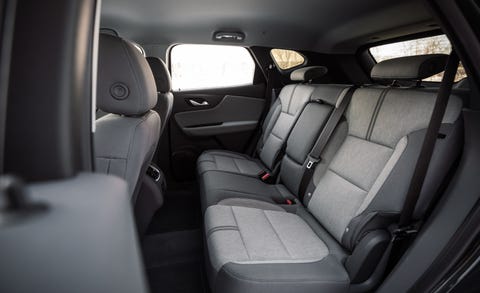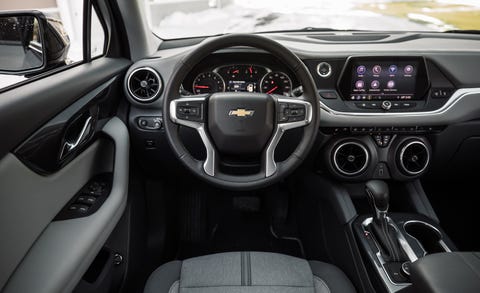There's no shortage of crossovers, but evidently there aren't nearly enough crossover names. Hence the return of the the Blazer, which earlier this year Chevy slipped between the Equinox and Traverse in its phalanx of utes. Of course, we've already been down that road, having compared the V-6-powered torque-vectoring all-wheel-drive Blazer RS with its most obvious rivals. That truck skirted the pointy end of the middleweight class thanks to a near-$51,000 asking price. It was great to drive and well kitted out, but its cost and packaging had the Blazer RS finishing third in a field of five.
This month, the volume-selling Blazer finds itself wired up with our test gear. This LT-trim front-drive four-cylinder model is the counter to our comparo car, complete with cloth seats, dialed-back dynamics, and a buffet of grayscale interior plastics. It's an unfortunate combination in an SUV that borrowed its interior gestalt from the abbreviated confines of the Camaro. Its greenhouse is pinched with a low roof and a high waistline, an odd choice in a segment where high seating and good outward visibility are big attractions. And the ventilation controls—a bundle of tiny black buttons hidden below the center stack's protruding brow ridge—make even simple HVAC adjustments challenging.
Nonetheless, there's enough space to house six-footers in the sliding and reclining rear seats, even with large adults up front. And when those seats are folded flat, there's 64 cubic feet of cargo volume, enough to accommodate an entire denful of IKEA particleboard. There's a lot more space in here than in, say, a Mazda CX-5, but that's like comparing apples and Ferraris. The Mazda's cool refinement and cosseting materials stand in stark contrast to the Blazer's interior, which feels like a big dull place to put things that don't really matter.
It has an engine: a 2.5-liter inline-four good for 193 horsepower. Try hard and it'll push the Blazer to 60 mph in 8.1 seconds, which is perfectly adequate. That engine also routes 188 pound-feet of torque through a nine-speed automatic transmission. A toggle switch on the shifter hints at manual control, but the gearbox slurs its downshifts in a lethargic drawl that aptly summarizes this Blazer's response to any driver input. Steering? Braking? It does them. How's it ride? Like a mid-size SUV fitted with 65-series rubber, which is to say with a lot more compliance than its RS brother. Like so many of its counterparts, this near-base Blazer is an entirely tolerable family vehicle that neither offends nor arouses when used as designed. Don't expect your Blazer to inspire any mountain-road gymnastics and it won't ask much of you as a driver

Michael SimariCar and Driver
Perhaps this crossover's biggest problem is the existence of a small army of SUVs that are simply nicer and more practical for about the same money—which, in this case, is $35,340. Mazda's CX-5 and CX-9, which flank the Blazer's wheelbase and encompass about the same price range depending on the Chevy's configuration, are better choices. The CX-9, in particular, relieves the Blazer of its dignity by providing a third row and more cargo space and by producing compelling reactions from its controls. The Mazda also has substantially more power yet scores the same EPA-rated combined and city fuel-economy numbers as the Chevy and even beats it by 1 mpg on the highway.
That the Blazer does little to move SUVs forward is clear. That it will sell anyway should surprise no one.
Specifications



0 Nhận xét